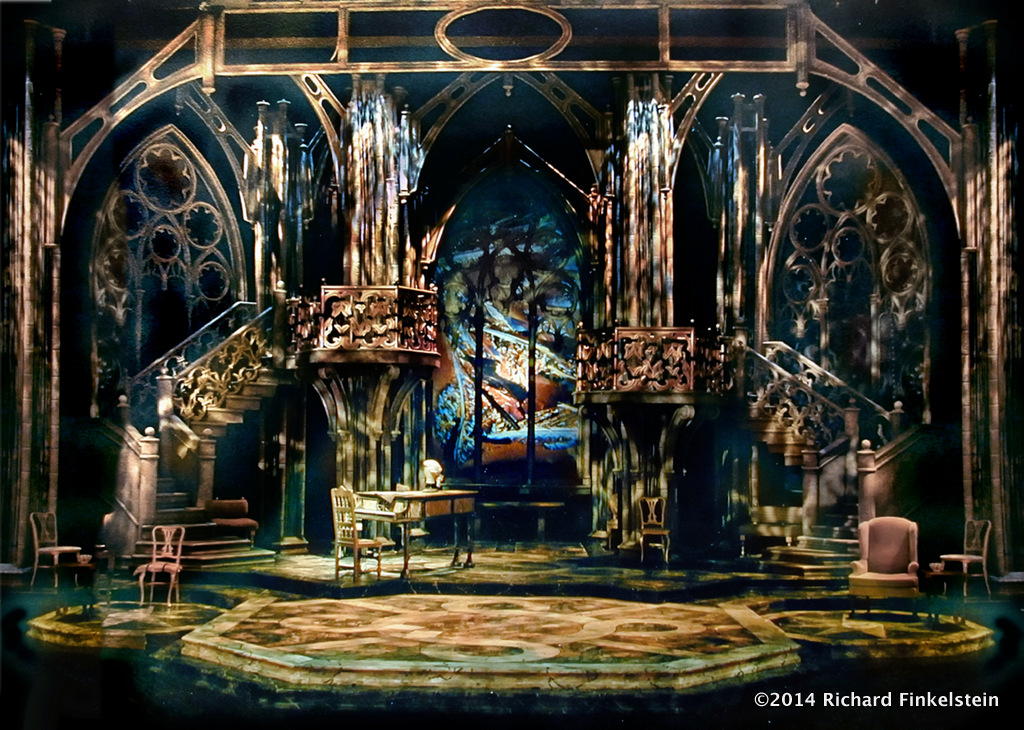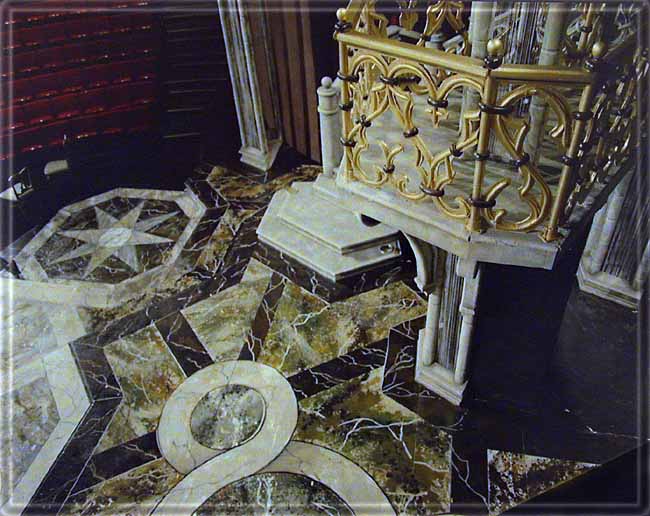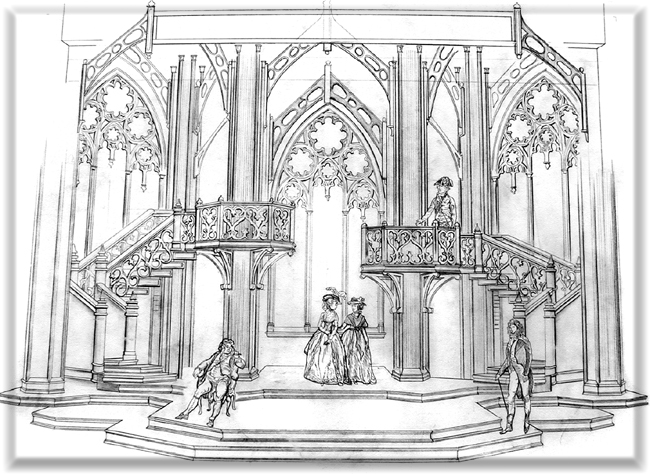|
|
Amadeus
- Production photograph of the 1987 production.
The Set Design and Projection Design is by Richard Finkelstein. Lighting is
by Lloyd S. Riford III

Above: The setting during the show
"preset".

Above: A view of the floor & SR.
pulpit under worklight

Hand Drawn perspective sketch

Above: The See-through harpsichord
|
Amadeus
(scenery and projection design)
Context/Pretext:
This production was designed for The New York State Theatre Institute. It afforded me the opportunity to experiment with a design that could change from the elegant, and palatial, to the austere and sparse as it reacts with the element of light. It also allowed me to explore techniques of what I would call "dissolving solids", three dimensional elements that can act like scrim. The production was designed so that it could look grand, but on a budget of only $4,000 (and it did come in at budget).
Description:
The playing space was in a cruciform shape into which elements of gothic (and some slightly Baroque) elements of architecture were introduced. There is a main playing space with satellite areas down stage to the sides. There are stairways left and right which lead to asymmetrical pulpit structures attached to cluster columns. At the rear on three sides are large sculptural gothic windows. Each of these supports a rear projection screen behind. Projections were provided through the use of 6 xenon slide projectors with additional Pani projection from the front.
The projections themselves were hand made and hand-painted slides of abstract textures, largely drawn from my library of over 2,000 projection designs.
The main columns as well as the harpsichord were each built in a skeletal manner, with added mass provided using string-drop techniques. This technique provided for the dissolving solids. The technique proved particularly innovative in the case of the harpsichord as it allowed the audience to actually see through the instrument to the player behind.
The floor surfaces were painted as dark marble while the structural elements were all painted as cold stone. The neutral coloring of the stone though allowed for further possibilities with the interaction of light.
With this production, I developed a technique allowing for 80 projection images to be tested against every single lighting cue. This meant that in the end, where projection elements were used, they were very exactly coordinated with, and integrated into the lighting design as a whole.
Design Conceptualization and Amadeus
Good playwrights communicate their ideas on many levels through their texts. The best playwrights are distinguished by their ability to explore a wide diversity of related concepts and philosophies, with each theme illuminating the other. Often these ideas are in opposition to each other, creating a wonderful sense of intellectual tension within the playwright's work.
Theater is, at its core, an exploration of human conflict. A work that presents just one facet of an idea lacks the ability to inspire an audience to ponder their own place within the scheme of human experience. The best works of theater, seem to embody the form of a debate where ideas are stated and reinforced, but are also simultaneously called into question by other ideas and implications. In this type of drama, the audience members are allowed to become "partners in creation" of the work as they attempt to resolve the issues in their own mind.
Theater of this kind is exciting. It reflects life where easy answers are non-existent, and reality is found in struggle, turmoil, and artificial boundaries. At first, Amadeus seems to reflect a rather simple good guy vs. bad guy motif. Mozart wears the white hat, while Salieri seeks to thwart his every move. On this level the play is exciting and rather entertaining, but the work goes far beyond this level, delving into some very serious social issues.
Among the ideas explored in the work, we find the following:
-
While we know that "money cannot buy happiness", what of social stature or artistic talent? Are either Salieri or Mozart successful as human beings? Are either of them fulfilled as individuals? Do either of them achieve a degree of happiness? In what ways are each of their life strategies flawed?
-
What are the further implications of Mozart's failed life? Is life really a question of good guy vs. bad guy? Are talented individuals talented in all areas?
-
In the duality of human nature, which takes or should take precedence: intellect or intuition? Salieri represents intellect; Mozart, intuition. Salieri finds his strength and power in his understanding of the political processes inherent in life. Mozart's strengths are far less structured and lie in his rather free-wheeling musical talent. Despite their strengths, each of these individuals are thwarted by the singular nature of their thought process. Salieri is missing the spontaneity and creativity of Mozart, while Mozart lacks the discipline of
Salieri. What are the implications of all this to our own personal development? What are the implications of all this to our system of educational development?
-
Man is in conflict with God, and indeed the nature of God-human interaction is central to this work. This motif is worthy of further exploration. In the Bible, we have the stories of Moses striking the rock against God's will, the stories of Job and Jonah, and even the story of Jacob. In each of these, the individual was ultimately strengthened by the tempering fires of God-human conflict. To this day, many religions and societies reflect this tradition of sparring with God. (For a very exciting exploration of this theme, listen to a recording of Leonard Bernstein's
Kaddish.)
-
Must art be imbued with genius in order to be valued?
Design Conceptualization and Genesis
At the start of our discussions, the production's director drew an interesting analogy between music and light. He felt that light must become a vital element to this production as it represents the physical embodiment of music. It was also clear that the play had an extremely fluid nature. Each scene segues (a musical term in its own right) into the next, flowing much as Mozart's music. The action itself follows a Mozart motif wherein many sub-themes, and even time frames, are placed in counterpoint as they are expressed almost simultaneously.
The elements of intellectual counterpoint provided for the genesis of the set. What I looked for was, in particular, an analogy between the worlds of music and architecture. I found this at the intersection between the worlds of the Baroque and the Gothic.
Both of these styles provide for a reflection of the majesty of the music of Mozart, but each style has a particular significance within the counterpoint. Baroque forms are free-flowing and ornamental as was the music and creative expression of Mozart. The world of Saliari, however finds a strong analogy in the more predictable, austere, stiffer, geometries of the Gothic style.
The inclusion of the Gothic motif gives voice to many dramaturgical concepts. It allows for the vast spaces necessary for the expression of dramatic action. It provides constant reminders of the central position of God and religion to the work and to the lives of the play's characters. Within the Gothic motif, the piano becomes the
dais, the sacrificial table, the icon. The structure of the pulpit asserts man's nature as judge against his fellow man.
No architectural form depends on the interaction of light more than that of the Gothic period. The unique sculptural elements, structural forms, and vast decorative elements were all designed to capture and use light as a design motif. Use of these forms an stage greatly reinforces the ability to use light as a design element. Here, I helped things along by providing lots of surfaces to enjoy the interplay of light. The spaces between these surfaces gain an importance all their own, allowing light to wrap around, pierce, and thrust through the space. The windows, with their rear-projection facility, are also designed as a surface for the interplay of light. In this physical environment, the entire mood of the piece shifts as the light qualities on the windows and other surfaces are modified.
Just as the music of Mozart works in abstraction, so too do I aim in the set to express the essence of place rather than literal location. While the set has a definite church-like feel, b it clearly is not a church. It might just as easily represent a palace. The duality of the setting here helps to blur the lines between the powers of God and that of the monarchs, and of mortal man. Individual settings are merely suggested as well, allowing the action to flow freely. Specific settings are suggested through the use of appropriately chosen and re-dressed furniture groupings, and through the "magic of light." Architectural elements can intrude and overwhelm, or they can disappear, or recede, leaving an environment of isolation.
|
|




